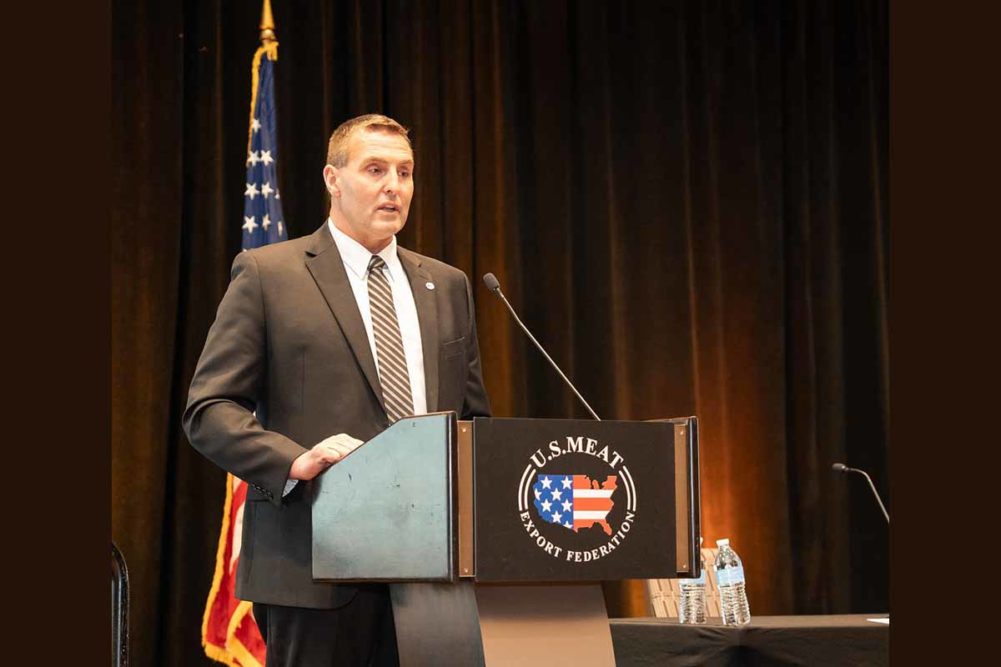DENVER — The US Meat Export Federation (USMEF) held its Strategic Planning Conference from Nov. 8-10 in New Orleans, La., to examine several topics impacting the global demand for US red meat products.
The conference started out with a welcome address from Dean Meyer, the USMEF chair, and livestock and grain producer from Rock Rapids, Iowa, reminding attendees about the benefits of the organization and bringing together various parts of agriculture to work toward common objectives.
“Regardless of the sector we are based in, we’re able to come together on most issues and provide a unified voice,” Meyer said. “And I don’t need to tell you, American agriculture needs that unified voice now more than ever because there are critical programs and issues that need our support.”
Later in his remarks, Meyer highlighted the urgent need for progress in crafting a new Farm Bill and reauthorizing agricultural appropriations, including critical programs for the US meat and livestock industries. He also emphasized the protection of US livestock from foreign animal diseases. He mentioned that December would be the 20th anniversary of the first BSE case in the United States, leading to most international markets halting US beef imports.
Keynote speaker Alexis Taylor, USDA undersecretary for trade and foreign agricultural affairs, spoke on the Regional Agricultural Promotion Program (RAPP), the new market development program recently announced by Agriculture Secretary Tom Vilsack.
The agency plans to use $1.3 billion from the Commodity Credit Corporation to fund RAPP to diversify export markets for US agricultural products. Taylor said the USDA is “feverishly working” to finalize the details and will provide more information about the program, including applying for RAPP funds.
Taylor then participated in a panel with USMEF staff to consider how the association leverages industry investments in export markets.
John Hinners, senior vice president of industry relations for USMEF, started the discussion by citing a recent Texas A&M University study that found every dollar invested in USDA export market development programs returned an average of $24.50 to the industry.
Hinners also explained a critical strategy that USMEF utilizes to leverage industry investments in export markets: third-party contributions.
Jihae Yang, USMEF vice president of Asia Pacific, emphasized the analytical approach the association used to develop specific market strategies. She said knowing where and how to invest is critical, and working in country enables USMEF staff to analyze individual markets, understand supply chains and build long-term relationships with businesses. Yang provided return-on-investment examples for specific promotions in which sales were calculated against USMEF’s investments, along with those of promotional partners.
Next, Homero Recio, a representative from USMEF Latin America, reviewed the training and evaluation program in Colombia to help butcher shops improve operational practices and increase sales in the United States.
The butcher shop program, which was primarily developed for retail outlets owned by importers, improves food safety practices, customer service standards, product handling, packaging and merchandising. Recio shared investment and sales data for specific Colombian importers enrolled in the program.
Finally, Nebraska Governor Jim Pillen addressed the conference and discussed his career as a veterinarian and pork producer.
Pillen recalled early in his career that the United States was a net importer of pork. He expressed appreciation for the USMEF’s efforts to expand global demand and highlight US red meat.
“We have to work together to defend agriculture, grow agriculture and sell it all over the world,” Pillen said. “And it’s important we’re very, very transparent, so that we can maintain the trust we’ve earned as the most respected producers in the world.”
Pillen also mentioned recent trade missions to Vietnam, South Korea and Japan, where he said it was a great privilege to represent Nebraska agriculture and promote US products.
Dan Halstrom, president and chief executive officer of USMEF, provided an update during the conference about the current state of red meat exports, along with an outlook for 2024.
He emphasized Mexico as a market in which both US pork and beef are performing exceptionally well, with pork exports achieving broad-based growth in 2023 with demand accelerating in Central America and the Caribbean. Halstrom noted that the United States is recapturing market share from European pork in several Asia Pacific destinations.
Later in his comments, Halstrom stated that even with significant headwinds, the US beef industry has opportunities to capture new customers, mainly by highlighting the value and versatility of underutilized beef cuts.


